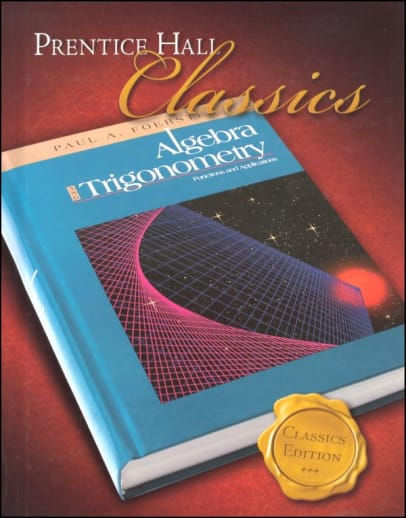It's here - the recommended sequel to the Jacobs math series. Paul Foerster taught math beginning in 1961 and puts his teaching expertise to work in this text which is designed as a course in intermediate and advanced algebra and trigonometry. After completing algebra 1 and geometry, this book is the next step before calculus. The presentation emphasizes the role of algebra and trigonometry as the foundation for calculus and should take a student 1 ½ to 2 years for completion.
The text is divided into 15 chapters, beginning with a brief review. Chapters 1-8 cover topics that are considered intermediate algebra, 9-12 are advanced algebra, and 13-15 cover trigonometry. Chapters include functions & relations, linear functions, systems of linear equations & inequalities, quadratic functions & complex numbers, exponential & logarithmic functions, rational algebraic functions, irrational algebraic functions, quadratic relations & systems, higher-degree functions & complex numbers, sequences & series, probability/data analysis/functions of a random variable, trigonometric & circular functions, properties of trigonometric & circular functions, and triangle problems.
The appendices offer additional topics that are sometimes part of Advanced Algebra but don't fit into the flow of the text. The topics are operations with matrices, mathematical induction, and exploration of functions. Explanations, exercises, and activities are provided for each topic and you can choose to present them as part of your program. Helpful reference tables, a glossary, and a skills handbook provide additional helps. There are chapter reviews, cumulative reviews, chapter tests, and a final exam found in the text. Note that these are different from those found in the test booklet. An answer key is found at the back of the book for odd-numbered problems in exercises and cumulative reviews, all problems in the chapter reviews, and select problems for appendices exercises, but not for chapter tests or the final exam.
Each chapter begins with a statement of the chapter's content and is broken into lessons. Lessons include instruction, objectives, examples, and practice exercises. Throughout the lessons the student will find blue boxes that contain definitions of important vocabulary and terms. Problems titled "Do These Quickly" provide opportunity for review of previous concepts, and discovery exercises expose students to new concepts before they are presented as a lesson. Calculators and/or a computer are recommended for use at appropriate times.
The Solutions Manual offers answers to all problems found in the text (with the exception of the simplest problems or problems that have more than one possible way to solve them as in linear equations with 3 variables), along with step-by-step solutions for most problems. Teaching resources, such as the Math Without Borders thumb drives are also available separately for this course.
This thorough course does an excellent job of preparing students for calculus and college level math. If you were to compare this course to Saxon Advanced Math, the only thing not included in this course is the interwoven geometry included in the Saxon course. ~ Donna

